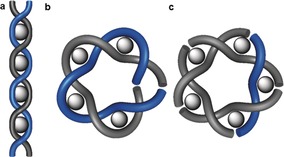Figure 19.

Transition from a linear double helicate to a circular double helicate. a) One of the limiting factors of the linear helicate approach is the increasing distance between the ends. b) Bending the helix brings the ends closer together, but does not reduce the length (and complexity) of the ligand strands. c) In a circular helicate, an additional metal ion brings additional organization to the ends of the helix. The symmetry enables shorter (simpler) ligands to be used at the cost of requiring more reactions (five as opposed to two for the linear helicate in the case of a 51 knot) to achieve closure of the loop.
